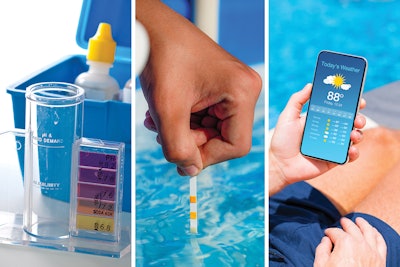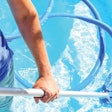
Testing methods and backyard connectivity have taken on a whole new meaning today. Many of us who have been involved in the swimming pool industry can remember how simplistic and unsophisticated our water testing products were years ago. The lack of attention to pool chemistry resulted in warranty and sanitation issues due to improper pool water chemistry.
The good news is the industry responded, and water testing methods improved. The manufacturers set out to make their testing equipment easier to use with more accuracy. We now have many innovative ways to test and maintain our pool, hot tub, and spa water chemistry and balance. There are new ways to monitor the water chemistry with systems that alert the user when water becomes unbalanced. These systems even indicate what steps a pool owner needs to take to correct any given condition. Builders now routinely install equipment that automatically monitors and maintains the pool, hot tub, and spa chemistry. The pool owner can simply look at their phones and know in an instant the condition of their pool.
This article explains the current major testing methods and new technology of backyard connectivity.
Test kits for monitoring the water quality in backyard pools, hot tubs, and spas have been around for years. These test kits are essential for balancing the water so that it is neither corrosive nor scaling. They also help the pool, hot tub, or spa owner to maintain the sanitizer level to keep the water free of microbes/germs that cause recreational water illnesses (RWI). There are four testing methods used in these test kits:
A. Colorimetric
B. Turbidimetric
C. Titrimetric
D. Electrochemical
Let's Start With Colorimetric Methods
Colorimetric methods use reagents that are added to a water sample, which react with a chemical in the water and a color develops. The amount of color that develops is directly related to the concentration of a chemical in the water. To determine the concentration of the chemical, the color is measured. There are two ways to measure the color: visually or photometrically.
Visual measurements require the operator to match the developed color of the reaction with a set of color standards. Color standards can be as simple as printed color charts or a color comparator. When using a color comparator, avoid looking towards dark colors, such as trees and flowers, and avoid direct sunlight. Note: Color blindness is much more common in men than in women. Visual color measurements are subjective.
Photometric color measurements are made electronically with a transmittance photometer (meter that measures light). These are sometimes also called colorimeters. These devices measure transmitted light. The intensity of light is first measured for a clear and colorless sample and that data is stored. Next, the intensity of light is measured for the reacted colored sample and that data is stored. The color in the reacted sample will absorb some of the light, and the intensity of the light will be less than for the colorless sample. This change in intensity is used to calculate the concentration of the chemical in the water. Photometers are not affected by the surrounding light or the vision of the operator. Photometers give objective measurements.
Test strip scanners are another design of photometers that use reflected light to measure color instead of transmitted light. There are two basic types of test strip scanners: dedicated/specialized scanners and mobile phone apps. The electronics/ microprocessor in both the test strip scanner and the mobile phone app uses algorithms to process the measured color output and display the concentration of the chemical in the water. In general, because the test strip scanners have a dedicated light source and a sample chamber, they are less affected by variation in the ambient light conditions and positioning and orientation of the test strip. These devices also give objective measurements.
The advantages of visual colorimetry are low cost and rugged devices that may require less maintenance. The disadvantages are less resolution in the measurement and the subjective nature of the measurement. The disadvantages of photometers are higher costs and a little more maintenance, such as battery changes. The advantages of photometers are higher resolution results, objective measurements, and digital data. Digital data allows for such things as time/date stamps, data-logging, digital data corrections, and connectivity (i.e., Wi-Fi, Bluetooth, and USB) to pool, hot tub, and spa software for water treatment, service management and routing.
Turbidimetric Methods
Turbidimetric methods measure the amount of turbidity/cloudiness in a water sample. Turbidity is the opposite of clarity. Turbidity is a result of small particles that scatter light. The pool, hot tub, or spa water may have turbidity due to insoluble dirt and debris, precipitating chemicals, and algae.
Turbidity in pool, hot tub, and spa water is most often measured visually. The main drain at the bottom of a pool must be visible from a certain distance. The bottom of a hot tub or spa must be clearly visible at its deepest point (see ANSI/APSP/ ICC-11 2019, American National Standard for Water Quality in Public Pools and Spas, section 8.2). There are electronic instruments similar to photometers, called turbidity meters or nephelometers, for measuring turbidity. These instruments are not normally used in the pool, hot tub, and spa industry because of their high cost, and visual measurements may be better for recreational water applications.
There is at least one turbidimetric method that uses chemical reagents. The test for cyanuric acid (CYA) uses a reagent that reacts with the CYA in the water, and turbidity/cloudiness develops. The amount of turbidity that develops is directly related to the concentration of CYA in the water. The turbidity can be measured visually or photometrically. The same pros and cons exist for turbidimetric CYA measurements using visual or photometric methods, as described previously for colorimetric measurements.
Titrimetric Methods
A quantitative form of measuring a chemical parameter, such as alkalinity, can be achieved through a titrimetric method. This type of measurement needs three things to be effective: a known volume of sample water, an indicator reagent, and the titrant reagent of known concentration.
There are a couple of different ways this can be accomplished. A popular way is a field method called a drop test. A water sample is collected poolside and put into a vial with volume markings and filled appropriately. A specific amount of indicator solution is added to the correct sample size and mixed. Ideally, the solution will turn a color that indicates the parameter is in the water or in some cases, that it is not in the water. When the indicator shows the chemical in the water, the titrant is added to the water sample, mixing and counting each drop until the endpoint color has been achieved. The total amount of titrant added to the sample is calculated and transformed into a result that is recorded.
A variation on how a titrant can be dispensed is a syringe that is filled with the titrant and dispensed by depressing the plunger slowly and mixing to see a color change. When the color change is obtained, the result is read on the syringe directly.
In a lab setting (which could be set up in a store), the principles are the same, with variations on how the three components are obtained and/or dispensed. In this setting, volumetric glassware may be used. This allows the operator to obtain a more precise reading.
Electrochemical Methods
Electrochemical methods directly measure the chemical without the use of reagents. Common parameters measured this way are salt, total dissolved solids (TDS), oxygen reduction potential (ORP), and pH.
Salt and TDS meters use conductance and are conductivity meters. These meters apply a potential or voltage across two electrodes and measure the current flow through the water. The unit of measure for conductivity is microSiemens (uS/ cm). Salt and TDS meters have a conversion factor to display ppm salt or TDS. There are small pocket/pen meters, meters with a cabled probe and inline meters. The electrodes can be made from stainless steel, graphite, platinum, or other inert materials. The electrodes should be rinsed off after use and checked for dirt or scale build up. These electrodes can be stored dry. These meters can and should be calibrated with a standard solution. Some meters may have data storage and communication capabilities.
pH meters are potentiometers (measure voltage) with a hydrogen ion-specific electrode and a reference electrode. The hydrogen ion electrode is made from thin glass. The glass is often bulb shaped and is fragile, but there are flat electrodes that are less fragile. As the pH changes, the voltage of the glass electrode changes. The voltage is converted to a pH reading by the electronics. The pH measurement is also affected by temperature, and most pH meters have a temperature sensor that corrects the pH reading. There are small pocket/pen meters, meters with a cabled probe, and inline meters. pH electrodes are very sensitive to calibration and should be calibrated often. Calibration solutions are required for use of a pH meter. The glass electrode should be rinsed off with deionized water after each use. The electrode should be stored wet in a buffer storage solution but not deionized water. Some meters may have data storage and communication capabilities.
ORP meters are potentiometers that measure the oxidation reduction potential (ORP) of pool, hot tub, or spa water. The addition of oxidizers to the water can change the ORP of the water. These include chlorine, bromine, ozone, peroxide, and monopersulfate. ORP meters use one inert metal electrode and a silver/silver chloride reference electrode. The voltage between these two electrodes is measured and is reported as the ORP in millivolts (mV). ORP is not a direct measurement of the concentration of oxidizers in the water because many things affect the reading. ORP is affected by changes in pH, CYA and temperature. As with the other meters, ORP meters are available with separate cabled probes, pocket meters, and inline probes. ORP probes do not normally need to be calibrated. They are relatively rugged. They should be rinsed off after use and checked for dirt or scale. The electrodes are normally stored wet in a storage solution or deionized water. Some meters may have data storage and communication capabilities.
Overall Backyard Connectivity
In addition to testing methods, other operating systems in the pool, hot tub, or spa environment need to be discussed. Pumps, heaters, and chemical feeders have had remote monitoring for much of the 21st century. Setting speeds, temperature, and sanitizer dispensing remotely is an advantage to the pool owner.
Several systems have been introduced to the market to determine the chemical parameters of the pool, hot tub, or spa water without being poolside. Parameters, such as pH, free chlorine, bromine, and total alkalinity, use colorimetric, titrimetric, and electrochemical methods in an electronic system. Results are sent wirelessly to an app, which can tell you how to treat your pool water. In addition, results can be sent directly to automated feeders. This is usually done for pH and ORP control.
Information supplied by the manufacturers will help you determine what level of connectivity you want from your backyard to your mobile device.
Maintaining proper water chemistry is more important today than ever before. It seems that every day, another infectious pathogen threatens our health. The best way to protect swimmers is to make sure pool water is safe and sanitary to use by correctly testing water frequently and treating accordingly.
This article first appeared in the September 2022 issue of AQUA Magazine — the top resource for retailers, builders and service pros in the pool and spa industry. Subscriptions to the print magazine are free to all industry professionals. Click here to subscribe.




























